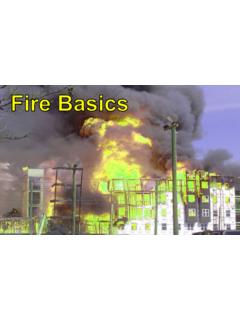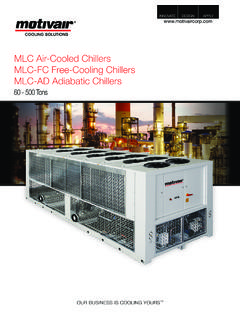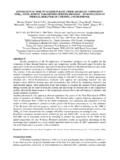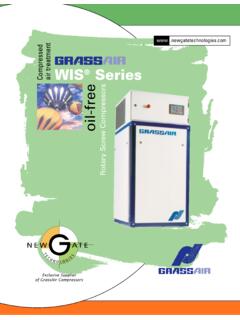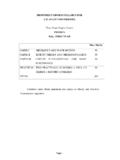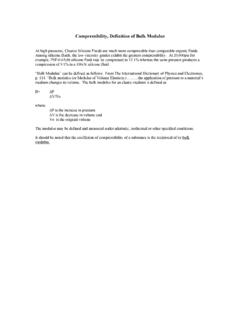Transcription of FLUID MECHANICS TUTORIAL 9 COMPRESSIBLE …
1 FLUID MECHANICS TUTORIAL 9 COMPRESSIBLE FLOW On completion of this TUTORIAL you should be able to define entropy derive expressions for entropy changes in fluids derive Bernoulli's equation for gas derive equations for COMPRESSIBLE ISENTROPIC flow derive equations for COMPRESSIBLE ISOTHERMAL flow solve problems involving COMPRESSIBLE flow derive equations for shock waves solve problems involving shock waves Let's start by revising entropy. 2 1. ENTROPY DEFINITION You should already be familiar with the theory of work laws in closed systems. You should know that the area under a pressure-volume diagram for a reversible expansion or compression gives the work done during the process. In thermodynamics there are two forms of energy transfer, work (W) and heat (Q). By analogy to work, there should be a property which if plotted against temperature, then the area under the graph would give the heat transfer.
2 This property is entropy and it is given the symbol S. Consider a p-V and T-s graph for a reversible expansion. Figure 1 From the p-V graph we have W = pdV From the T-S graph we have Q = TdS This is the way entropy was developed for thermodynamics and from the above we get the definition dS = dQ/T The units of entropy are hence J/K. Specific entropy has a symbol s and the units are J/kg K It should be pointed out that there are other definitions of entropy but this one is the most meaningful for thermodynamics. A suitable integration will enable you to solve the entropy change for a FLUID process. 3 2. ISENTROPIC PROCESSES The word Isentropic means constant entropy and this is a very important thermodynamic process. It occurs in particular when a process is reversible and adiabatic .
3 This means that there is no heat transfer to or from the FLUID and no internal heat generation due to friction. In such a process it follows that if dQ is zero then dS must be zero. Since there is no area under the T-S graph, then the graph must be a vertical line as shown. Figure 2 There are other cases where the entropy is constant. For example, if there is friction in the process generating heat but this is lost through cooling, then the nett result is zero heat transfer and constant entropy. You do not need to be concerned about this at this stage. Entropy is used in the solution of gas and vapour problems. We should now look at practical applications of this property and study the entropy changes which occur in closed and steady flow systems for perfect gases and vapours. These derivations should be learned for the examination.
4 4 3. ENTROPY CHANGES FOR A PERFECT GAS IN A CLOSED SYSTEMS Consider a closed system expansion of a FLUID against a piston with heat and work transfer taking place. Figure 3 Applying the non-flow energy equation we have Q + W = U Differentiating we have dQ + dW = dU Since dQ = TdS and dW = -pdV then TdS - pdV = dU TdS = dU + pdV This expression is the starting point for all derivations of entropy changes for any FLUID (gas or vapour) in closed systems. It is normal to use specific properties so the equation becomes Tds = du + pdv but from the gas law pv = RT we may substitute for p and the equation becomes Tds = du + RTdv/v rearranging and substituting du = cv dT we have ds = cv dT/T + (1) s is specific entropy v is specific volume.
5 U is specific internal energy and later on is also used for velocity. 5 ISOTHERMAL PROCESS Figure 4 In this case temperature is constant. Starting with equation (1) ds = cv dT/T + Rdv/v. since dT = 0 then s2 - s1 = s = R ln(v2/v1) A quicker alternative derivation for those familiar with the work laws is: 21211212121212ln since and lnlnlnSconstant. is Tbut ln WandW - Q then 0 Ubut ppRsppvvvvRsVVmRSVVmRTWTQSTTdsQVV -mRT UWQ= == = = == ===== =+ 6 CONSTANT VOLUME PROCESS Figure 5 Starting again with equation (1) we have ds = cvdT/T + Rdv/v In this case dv=0 so ds = cvdT/T Integrating between limits (1) and (2) s= cv ln(T2/T1) CONSTANT PRESSURE PROCESS Figure 6 Starting again with equation (1) we have vdvRTdTCdsv+= In this case we integrate and obtain 1212lnlnvvRTTCsv= For a constant pressure process, v/T = constant 1122 TTvv= so the expression becomes ()112212lnlnlnTTRCTTRTTCsvv+=+= It was shown in an earlier TUTORIAL that R = cp - cv hence 12lnTTCsp= 7 POLYTROPIC PROCESS This is the most difficult of all the derivations here.
6 Since all the forgoing are particular examples of the polytropic process then the resulting formula should apply to them also. Figure 7 The polytropic expansion is from (1) to (2) on the T-s diagram with different pressures, volumes and temperatures at the two points. The derivation is done in two stages by supposing the change takes place first at constant temperature from (1) to (A) and then at constant pressure from (A) to (2). You could use a constant volume process instead of constant pressure if you wish. s2-s1 = (sA-s1) - (sA-s2) s2-s1 = (sA-s1) + (s2-sA) For the constant temperature process (sA-s1) = R ln(p1/pA) For the constant pressure process (s2-sA) = (cp) ln(T2/TA) Hence ++= ApATTCppRs21lnlns2-s1 Since pA = p2 and TA= T1 Then s = s2-s1 = 1221lnlnTTCppRp+ Divide through by R 1221lnlnTTRCppRsp+= From the relationship between cp, cv, R and we have cp/R = /( -1) Hence 1221ln1lnTTppRs += 11221ln = TTppRs This formula is for a polytropic process and should work for isothermal, constant pressure, constant volume and adiabatic processes also.
7 In other words, it must be the derivation for the entropy change of a perfect gas for any closed system process. This derivation is often requested in the exam. 8 WORKED EXAMPLE No. 1 A perfect gas is expanded from 5 bar to 1 bar by the law = C. The initial temperature is 200oC. Calculate the change in specific entropy. R = 287 J/kg K = SOLUTION J/kgK x )5( = = = = SELF ASSESSMENT EXERCISE No. 1 1. Calculate the specific entropy change when a perfect gas undergoes a reversible isothermal expansion from 500 kPa to 100 kPa. R = 287 J/kg K. (Answer + J/kg K). 2. Calculate the total entropy change when 2 kg of perfect gas is compressed reversibly and isothermally from 9 dm3 to 1 dm3. R=300 J/kg K. (Answer kJ/k) 3. Calculate the change in entropy when kg of perfect gas is heated from 20oC to 100oC at constant volume.
8 Take cv= 780 J/kg K (Answer 470 J/K) 4. Calculate the total entropy change when 5 kg of gas is expanded at constant pressure from 30oC to 200oC. R = 300 J/kg K cv= 800 J/kg K (Answer kJ/K) 5. Derive the formula for the specific change in entropy during a polytropic process using a constant volume process from (A) to (2). 6. A perfect gas is expanded from 5 bar to 1 bar by the law pV = C. The initial temperature is 200oC. Calculate the change in specific entropy. R = 287 J/kg K = (Answer -144 J/kg K) 7. A perfect gas is expanded reversibly and adiabatically from 5 bar to 1 bar by the law pV = C. The initial temperature is 200oC. Calculate the change in specific entropy using the formula for a polytropic process. R = 287 J/kg K = (The answer should be zero since the process is constant entropy). 9 Let's go on to apply the knowledge of entropy to the flow of COMPRESSIBLE fluids starting with isentropic flow.
9 4. ISENTROPIC FLOW Isentropic means constant entropy. In this case we will consider the flow to be adiabatic also, that is, with no heat transfer. Consider gas flowing in a duct which varies in size. The pressure and temperature of the gas may change. Figure 8 Applying the steady flow energy equation between (1) and (2) we have : - P = U + + + For adiabatic Flow, = 0 and if no work is done then P = 0 U + = H hence : 0 = H + + In specific energy terms this becomes : 0 = h + + rewriting we get: h1 + u12/2 + g z1 = h2 + u22/2 + g z2 For a gas, h = Cp T so we get Bernoulli's equation for gas which is : CpT1 + u12/2 + g z1 = C pT2 + u22/2 + g z2 Note that T is absolute temperature in Kelvins T = oC + 273 10 STAGNATION CONDITIONS If a stream of gas is brought to rest, it is said to STAGNATE.
10 This occurs on leading edges of any obstacle placed in the flow and in instruments such as a Pitot Tube. Consider such a case for horizontal flow in which may be neglected. Figure 9 u2 = 0 and z1 = z2 so CpT1 + u12/2 = C pT2 + 0 T2 = u12/2Cp + T1 T2 is the stagnation temperature for this case. Let T2 - T1 = T = u12/2Cp T = u12/2Cp Now Cp - Cv = R and Cp / Cv = is the adiabatic index . hence Cp = R / ( - 1) and so : T = u12 ( - 1) / (2 R) It can be shown elsewhere that the speed of sound a is given by : a 2 = RT hence at point 1: T / T1 = u12 ( - 1) / (2 RT1) = u12 ( - 1 ) /2a12 The ratio u/a is the Mach Number Ma so this may be written as : T / T1 = Ma2 ( - 1 ) /2 If Ma is less than then Ma2 is less than and so T/T1 is less than It follows that for low velocities, the rise in temperature is negligible under stagnation conditions.










